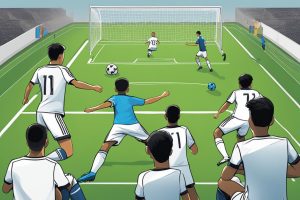How to Analyze Set Pieces in Soccer: A Comprehensive Guide
Set pieces are an essential part of soccer that can make or break a team’s chances of winning a match. A set piece is a situation in which the ball is stationary and the game is restarted after a stoppage in play. These include free kicks, corner kicks, throw-ins, and penalty kicks. Analyzing set pieces in soccer is a crucial aspect of the game, as it can help teams improve their efficiency and increase their chances of scoring goals.

To analyze set pieces in soccer, one must first understand the fundamentals of set pieces. This includes knowing the different types of set pieces, such as direct and indirect free kicks, as well as corner kicks and throw-ins. It is also important to understand the preparation and training that goes into executing set pieces effectively. This includes practicing set piece routines and ensuring that players are in the right positions on the field.
Analyzing set piece execution involves a combination of statistical analysis and video analysis techniques. Statistical analysis can help determine which set pieces are most effective for a team, while video analysis can provide a visual representation of how a team executes their set pieces. By analyzing set pieces in soccer, teams can improve their efficiency and increase their chances of scoring goals, ultimately leading to more victories on the field.
Key Takeaways
- Understanding the fundamentals of set pieces is crucial for analyzing them effectively.
- Analyzing set pieces involves a combination of statistical and video analysis techniques.
- Improving set piece efficiency can lead to more victories on the field.
Fundamentals of Set Pieces in Soccer
Set pieces are crucial aspects of soccer that can make or break a team’s chances of winning a match. A set piece is a situation in which the ball is stationary and the game is restarted after a stoppage in play. These situations include free kicks, corner kicks, throw-ins, and penalty kicks.
To analyze set pieces in soccer, one must first understand the different types of set pieces and their respective rules. For example, during a free kick, the opposing team must be at least 10 yards away from the ball until it is in play. In a corner kick, the ball must be placed within the corner arc before it is kicked. Understanding these rules is essential to analyzing set pieces effectively.
Another fundamental aspect of analyzing set pieces is understanding the roles and responsibilities of each player on the field. For example, during a corner kick, players may be designated to mark opposing players, make runs into the box, or take the actual kick. Each player’s role is crucial to the success of the set piece, and analyzing their performance can provide valuable insights into a team’s strengths and weaknesses.
Finally, it is important to analyze the opposing team’s defense during set pieces. This includes understanding their formation, marking strategies, and communication. By analyzing the opposing team’s defense, a team can identify areas of weakness and exploit them during set pieces.
In summary, analyzing set pieces in soccer requires a thorough understanding of the different types of set pieces and their rules, the roles and responsibilities of each player, and the opposing team’s defense. By analyzing these factors, a team can improve their set piece performance and increase their chances of winning matches.
Types of Set Pieces
Set pieces are an important aspect of soccer as they provide teams with scoring opportunities. There are several types of set pieces, and each one requires a different strategy and approach. In this section, we will discuss the different types of set pieces in soccer.
Corner Kicks
Corner kicks occur when the ball goes out of bounds over the end line after being touched by a defending player. The attacking team is awarded a corner kick, and the ball is placed in the corner arc. The attacking team will then try to deliver the ball into the box for a teammate to head into the goal or take a shot on goal. Defending teams will try to clear the ball out of the box to prevent a scoring opportunity.
Free Kicks
Free kicks are awarded to a team when an opposing player commits a foul. The team awarded the free kick can choose to take a direct shot on goal or play a short pass to a teammate. Free kicks can occur anywhere on the field, and the location of the free kick will determine the approach taken by the attacking team.
Penalty Kicks
Penalty kicks are a type of free kick that is awarded to a team when a defending player commits a foul inside their own penalty area. The attacking team is awarded a penalty kick, and the ball is placed on the penalty spot. The attacking player will then take a shot on goal, with only the goalkeeper standing between them and the goal.
Throw-Ins
Throw-ins are awarded to a team when the ball goes out of bounds over the touchline. The team awarded the throw-in will then throw the ball back into play. Throw-ins require teamwork, and the attacking team will try to use the throw-in to create a scoring opportunity.
Goal Kicks
Goal kicks occur when the ball goes out of bounds over the end line after being touched by an attacking player. The defending team is awarded a goal kick, and the ball is placed in the six-yard box. The defending team will then try to clear the ball out of their own half to prevent a scoring opportunity.
In conclusion, understanding the different types of set pieces in soccer is essential for both attacking and defending teams. Each type of set piece requires a different strategy and approach, and teams must be prepared to take advantage of these opportunities to score goals.
Preparation and Training
When it comes to set pieces in soccer, preparation and training are key. Coaches need to have a solid strategy in place and make sure their team is trained to execute it effectively. This section will cover player roles and responsibilities, set piece strategies, and training drills for set pieces.
Player Roles and Responsibilities
Each player on the team has a specific role and responsibility when it comes to set pieces. For example, during a corner kick, the goalkeeper’s role is to protect the goal while the defenders mark the opposition’s attackers. The midfielders and forwards are responsible for creating space and making runs to receive the ball.
Set Piece Strategies
Having a set piece strategy is crucial for success. Teams can use a variety of strategies, such as playing short or long, crossing the ball in, or taking a shot on goal. The strategy used will depend on the team’s strengths and weaknesses as well as the opposition’s defensive setup.
Training Drills for Set Pieces
To execute set pieces effectively, teams need to practice them regularly. Coaches can use a variety of training drills to help players improve their technique and timing. For example, coaches can set up a scenario where the team practices taking free kicks from different angles or practicing corner kicks with different delivery techniques.
Overall, preparation and training are essential for success in set pieces. By understanding player roles and responsibilities, developing effective set piece strategies, and practicing with a variety of training drills, coaches can help their team improve their performance during set pieces.
Analyzing Set Piece Execution
When analyzing set pieces in soccer, there are several key factors to consider to determine their effectiveness. Here are some of the most important aspects to keep in mind:
Positioning and Movement
Positioning and movement are crucial to executing successful set pieces. The attacking team needs to create space and confusion in the defensive structure to create scoring opportunities. Effective attacking runs can create gaps in the defense and provide opportunities for players to get into scoring positions. On the defensive side, players must maintain their positions and mark their opponents tightly to prevent scoring opportunities.
Ball Delivery Quality
The quality of ball delivery is another critical factor in set piece execution. The ball must be delivered with accuracy, pace, and spin to give the attacking players the best chance of scoring. The delivery is usually done through a cross or a pass, and it is essential to choose the right type of delivery depending on the situation.
Defensive Structures
Analyzing the defensive structures of both teams is essential when analyzing set pieces. The defensive team must have a clear plan in place to prevent the attacking team from scoring. They must be well-organized and prepared to deal with different types of deliveries and attacking runs. The attacking team must identify weaknesses in the defensive structure and exploit them to create scoring opportunities.
Attacking Runs
Attacking runs are an essential part of set piece execution. The attacking players must make intelligent runs to create space and confusion in the defense. They must time their runs perfectly to meet the ball at the right moment and angle. The attacking team must also have a clear plan in place to confuse the defensive team and create scoring opportunities.
Overall, analyzing set piece execution requires a deep understanding of the game and the ability to identify weaknesses in the opposing team’s structure. By focusing on positioning and movement, ball delivery quality, defensive structures, and attacking runs, teams can increase their chances of scoring from set pieces.
Statistical Analysis
When it comes to analyzing set pieces in soccer, statistical analysis plays a crucial role in identifying the strengths and weaknesses of a team’s performance. This section will explore some of the key statistical metrics that can be used to analyze set pieces.
Success Rates
One of the most important metrics for analyzing set pieces is the success rate. This metric measures the percentage of set pieces that result in a goal or a shot on target. By analyzing the success rate of different types of set pieces, such as corners, free kicks, and penalties, coaches can identify which set pieces are most effective for their team and which ones need improvement.
Player Contributions
Another important aspect of set piece analysis is understanding the contributions of individual players. By tracking metrics such as goals scored, assists, and pass completion rates during set pieces, coaches can identify which players are most effective at creating scoring opportunities. This information can be used to make tactical decisions, such as which players should take set pieces or which players should be positioned in certain areas of the field during set pieces.
Opposition Analysis
Finally, analyzing the performance of the opposition team during set pieces can provide valuable insights into their strengths and weaknesses. By tracking metrics such as goals conceded and shots on target against different types of set pieces, coaches can identify areas where the opposition team is vulnerable and develop strategies to exploit these weaknesses.
Overall, statistical analysis is an essential tool for analyzing set pieces in soccer. By tracking key metrics such as success rates, player contributions, and opposition analysis, coaches can gain valuable insights into their team’s performance and develop effective strategies to improve their set piece performance.
Video Analysis Techniques
Video analysis is an essential tool for soccer coaches to improve their team’s set-piece performance. Here are some of the video analysis techniques that coaches can use to analyze set pieces.
Software Tools
There are several software tools available that can help coaches analyze set pieces. These tools allow coaches to view and analyze game footage, identify patterns and trends, and create visualizations of set-piece plays. Some popular software tools used by soccer coaches include Hudl, Veo, and YourSoccerMastery.
Key Frame Analysis
Key frame analysis is a technique used in video analysis to identify critical moments in a game. Coaches can use key frame analysis to identify important moments during set-piece plays, such as the moment the ball is kicked, the positioning of players, and the timing of runs. This information can help coaches identify areas for improvement and develop more effective set-piece strategies.
Pattern Recognition
Pattern recognition is another technique used in video analysis to identify patterns and trends in a team’s performance. Coaches can use pattern recognition to identify common set-piece plays, such as corner kicks or free kicks, and analyze the success rate of these plays. This information can help coaches develop more effective set-piece strategies and identify areas for improvement.
In conclusion, video analysis is an essential tool for soccer coaches looking to improve their team’s set-piece performance. By using software tools, key frame analysis, and pattern recognition, coaches can identify areas for improvement and develop more effective set-piece strategies.
Improving Set Piece Efficiency
Set pieces are an essential aspect of soccer, and teams that can execute them efficiently have an advantage over their opponents. Here are some ways to improve set piece efficiency.
Adapting Tactics
One way to improve set piece efficiency is to adapt tactics to the team’s strengths. Teams should consider the strengths of their players and develop set piece strategies that capitalize on them. For example, if a team has tall and strong players, they can focus on delivering the ball into the box for headers. On the other hand, if a team has quick and agile players, they can focus on short passes and quick movements to create new attacking angles.
Player Skill Development
Another way to improve set piece efficiency is to develop the skills of the players involved in set pieces. Players need to be trained to execute set pieces effectively. For example, players need to practice their free-kick and corner-kick taking skills to deliver the ball accurately into the box. Additionally, players need to practice their heading and shooting skills to take advantage of the opportunities created by set pieces.
In-Game Decision Making
Finally, in-game decision making is crucial to set piece efficiency. Players need to be aware of the game situation and make quick decisions based on the opposition’s defensive set up. For example, if the opposition has a tall and strong defender marking a team’s tall and strong player, the team may need to adapt their strategy and focus on short passes instead of delivering the ball into the box.
In conclusion, improving set piece efficiency requires a combination of tactics, player skill development, and in-game decision making. By adapting tactics to the team’s strengths, developing player skills, and making quick decisions in-game, teams can improve their set piece efficiency and gain an advantage over their opponents.
Frequently Asked Questions

What tactics are most effective for defending corner kicks in soccer?
Defending corner kicks is a crucial aspect of any soccer team’s strategy. One effective tactic is to use zonal marking, where players are assigned to cover specific areas of the penalty area rather than marking individual opponents. Another tactic is to use man-to-man marking, where each player is assigned to mark a specific opponent. It is important for defenders to communicate effectively and be aware of their surroundings to prevent the opposition from scoring.
Which statistical methods are best for evaluating a team’s performance on set pieces?
There are several statistical methods that can be used to evaluate a team’s performance on set pieces. One useful metric is the conversion rate, which measures the percentage of set pieces that result in a goal. Another metric is the number of opportunities created, which measures the number of set pieces a team is able to generate. It is important to analyze these statistics in conjunction with game footage to gain a more complete understanding of a team’s set piece performance.
How can a team improve its scoring rate from free kicks?
To improve a team’s scoring rate from free kicks, it is important to practice a variety of set piece routines and to identify the strengths of individual players. Coaches can also use game footage to analyze the opposition’s defensive weaknesses and tailor their set piece strategy accordingly. It is important for players to communicate effectively and be aware of their surroundings to create scoring opportunities.
What are the key factors to consider when preparing for an opponent’s set piece strategy?
When preparing for an opponent’s set piece strategy, it is important to analyze their previous games and identify their strengths and weaknesses. Coaches should also consider the opposition’s formation and the positioning of their players during set pieces. It is important for players to communicate effectively and be aware of their surroundings to prevent the opposition from scoring.
How do coaching strategies vary for different types of set pieces in soccer?
Coaching strategies can vary depending on the type of set piece. For example, corner kicks may require a different approach than free kicks or throw-ins. Coaches should consider the strengths of their players and the weaknesses of the opposition when developing their set piece strategy. It is important for players to communicate effectively and execute their roles with precision to create scoring opportunities.
What role does player positioning play in the success of set pieces?
Player positioning is crucial to the success of set pieces. For example, attackers may need to position themselves in areas of the penalty area where they are most likely to receive the ball. Defenders may need to position themselves to block shots or clear the ball from danger. It is important for players to communicate effectively and be aware of their surroundings to execute their roles with precision.







